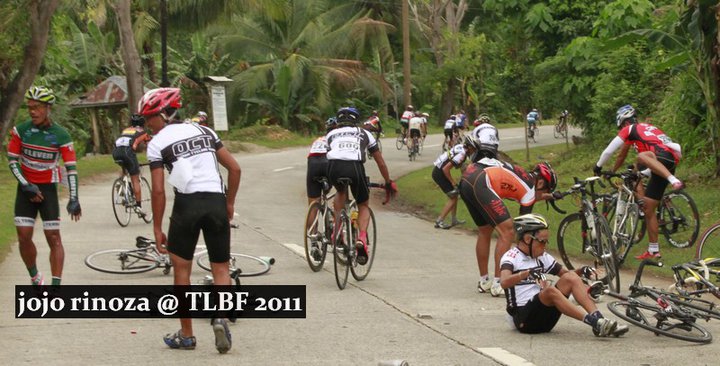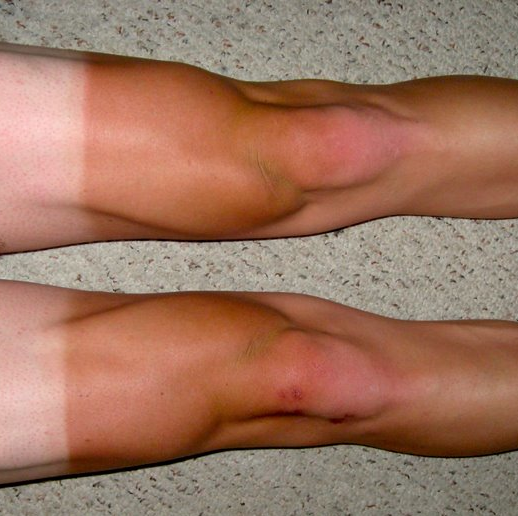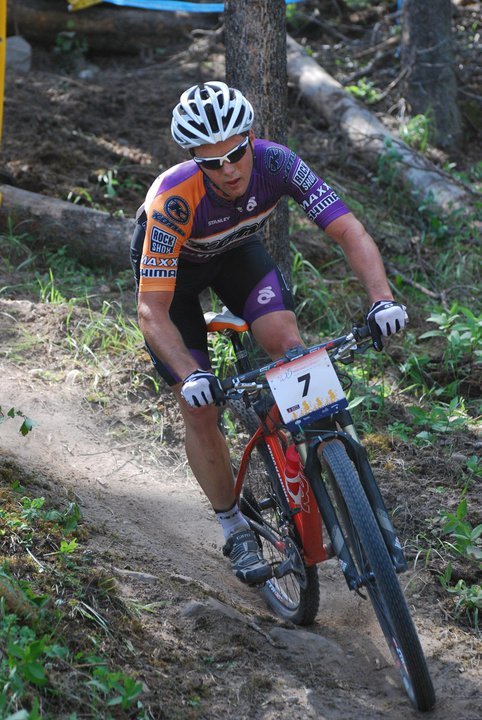Crashing seems to be rife in the cycling world, it almost is a normal occurrence that it is almost an accepted part of the sport. You see the pros crashing all the time, you see experienced riders in fast USA criteriums crashing out, you see inexperienced riders
The benefits of cycling is plain for all: you get fit and it has been promoted as “non-impact” sport that is easy on your joints, but when you crash it suddenly becomes a high impact sport that can leave you out of action for months. You see many new riders embracing the sport as they approach middle-age, it has certainly become the “new golf” and provides opportunities for social interactions on group rides. It also becomes competitive when riders start lining up at races, which are proliferating at a fast rate around the world. Most riders who are successful at racing or have been racing for a while would have invariably crashed at some point or another. If you have not yet crashed, it becomes a matter of when it will happen to you.
You can take precautionary steps to avoid crashing by riding conservatively and taking no risks at all, but sometimes external factors, beyond your control, will contrive to bring you down onto the tarmac for a heavy landing. Sometimes, crashing is completely unnecessary and is usually the result of careless riding or blatant risk taking. Crashes can happen just from a temporary lapse of concentration, wet surfaces, or a sudden change in the road width or direction when it is least expected. There are times when crashing can be excused and other times when it is completely uncalled for.
Bike racing involves a certain amount of risk taking, especially if you are a sprinter and the race is heading for a bunch gallop to the line. This 2011 season I’ve been quite lucky and have not been involved in any crashes, but in 2010 I did have several crashes one of which happened in a Shanghai race and also numerous close one’s in various races this year including this race in Xinyi and most recently narrowly avoiding coming down when two riders in the breakaway tumbled for no reason in the final lap in the Suzhou event.
Shanghai: Crash story
There is a race series in Shanghai that I took part in regularly for training last year. Its a pretty small race in my view with no prize money up for grabs and I treat it like a training fun race to gain fitness and practice certain tactics to try in bigger races, but some riders from the Shanghai area seem to treat this as a world championship which sometimes promotes risky behavior.
I got caught up in a crash that was completely unnecessary near the end of the final lap of one race. I was cruising along on the outside of the peloton looking to position myself to do well in the final sprint. I had no one on the right of me and had plenty of room to move, and I was moving up slowly but surely. On my left there was a rider who was anxious to get out of the peloton when he saw me cruise slowly by. Half of my bike was in front of him and he started to try and nudge his way out to which I responded by accelerating slightly but safely. The next thing I knew, another rider that was in front of him veered sharply into my path and went down. You can see it all unfold before your eyes like slow-motion and I did make it past the rider who went down, but my rear wheel was still in the air and as it crashed down, the weight of my body crashed down onto the saddle and caused the seat post to snap clean off. The next thing I knew I was lying on the ground with my bike on top of me! I get up to get back on the bike to at least try and finish the race, but the bike was mangled that it was not rideable. The guy who caused the crash, stayed upright and he finished second. The crash had taken out four of the top six contenders for the series overall win. My point here is to illustrate that this crash was completely avoidable if the rider had stayed where he was and moved out after I had passed him, he would still have time to pull out a good result. It so happens that this particular rider has a reputation for being dangerous and twitchy during races, it was not the first time that this particular had caused crashes by blatantly careless riding at such a small event.
USA Superweek crashes
Sure, I have had my fair share of crashes – most of them as a result of other crashes and other riders being aggressive towards me when wanting to take the wheel I am on. I recall one particular crash that was mostly my fault. It was during a Superweek race in the Chicago area and there is money up for grabs if you finish well. So there was well over 100 riders all vying for position in the closing laps. I had moved up into the top 30 and was looking good. In what I believed was the last lap and coming up to the final corner, I saw a small gap on my right that I thought I could slot into in order to move into the top 20 and launch my assault. These are types of scenarios riders are faced with in these kinds of races, and there is some degree of risk taking that you have to take to advance your position. This is an acceptable part of racing and I took the 50/50 gamble with trying to get myself into that small gap – it was closed by another rider who saw me coming and prevented me from getting a clean slot. This resulted in my handle-bars colliding and I lost balance and went straight down at 30 miles per hour (just over 50km/h) and slid across the road, ending my chances of a top finish and managing to get some serious road rash and damaging my bike. Was this my fault? Yes it was for taking the risk and no because the other rider saw me coming and closed that gap. Since I already committed to the move, I had no where to go.
Two years ago I was in another big crash at Superweek that was clearly caused by another rider’s unbridled aggression. I had been following a well-known sprinters wheel (he had motioned for me to follow) and within the space of one lap on the super fast Evanston course, I had moved from mid-pack of 200 riders to just outside the top 10 with only five laps remaining. I was feeling so good and believed that I would have a great chance of getting a great result in a pro race but there was a German pro rider who wanted the known-sprinters wheel that I was securely fastened on. He started elbowing me and trying to get me to concede. I would not budge, so on the next corner he repeated his tactic and I just kept my ground. The German rider was not going to give up and kept doing this to me for four corners. On the fourth corner he actually did a bigger shove and this pushed me straight up onto the curb, I was up on the curb with my handlebars rattling the barriers that were there. I had almost regained control and was trying to get back down onto the road when my handlebar caught the barrier and ripped right out and into the pack of riders. I went straight down, very hard. I believe I was slightly concussed and my hand and shoulders were the hardest hit. They had stopped the race and had the ambulance come on course ready to take me to the hospital, but I regained composure and declared that I was going to complete the race despite my bike being all beaten up and some bad body injuries. Sram neutral support got me one of their Sram equipped bikes with Zipp 404s and I was restarted the race on the borrowed bike. My adrenalin kept me going and I was able to collect 22nd (in the money). But I never knew who the culprit was, I was livid for a long time about how this rider was so aggressive to cause such a big crash. He obviously wanted the wheel I was on that badly. It goes to show how riders are willing to take unnecessary risks it to win or place well at all costs.
Real Cyclist?
As a sprinter myself, I am no stranger to risk taking. But I am more patient nowadays and know how to position myself better for the sprint so that it can be a clean safe sprint. Racing in New Zealand seems to be hard safe racing for the most part, although it appears that some serious crashing happened at New Zealand’s Tour of Southland for two years in a row that had a few riders broken bikes and bodies! Crashing is part of a cyclists life – if you are new to racing, you will crash invariably at some point or another. It happens to everyone. Some more serious than others like Wade Wallace’s article on The Broken Collarbone where if you are not considered a “real cyclist” if your collarbone has never been broken. I am in the same boat as Wade, I don’t want to break my bones just to prove that I am worthy of the title of real cyclist! I have been very lucky to some degree with my past crashes that I have not done any major damage. I still have neck and shoulder issues from my past crash injuries and need to see the chiropractor or physio from time to time.
Best riders in the World
When you watch the Tour de France or any major Pro Tour race, you can often see the best cyclists in the world crashing. Perhaps their risk taking is even bigger, when you have 200 guys galloping in for the bunch sprint at 65-70km/h and it only takes one guy to make a mistake to cause a domino effect where the bunch would demolish spectacularly. There is alot more at stake for these riders so they take more risks, both making dangerous moves as well as entering the world of doping (you can read a very interesting account New Pathways to Pro Cycling) to get an unfair competitive edge on rivals. The good thing is that cycling is slowly cleaning this up and the pro peloton has slower average speeds as a result of this.
Questions for discussion: What is your view on the risk taking element in the sport of road cycling? My next post will provide you with some tips to avoid getting into a potential crash situation and how to take calculated but safer risks.







Good Article, I fairly think it is not worth taking the risk… At the end of the day, patience is rewarding… getting to the front too early exposes you too… Ishmael